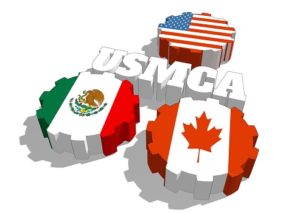NAFTA and USMCA
What is the North American Free Trade Agreement
How is it related to the U.S.-Mexico-Canada Agreement?
The North American Free Trade Agreement (NAFTA), which came into force on January 1, 1994, was an agreement signed by the governments of Canada, Mexico, and the United States that created a trilateral trade bloc in North America.
It has become one of the largest trade blocs in the world today. Beginning in 1994 NAFTA allowed thousands of U.S. companies to reorganize their production and open factories in Mexico. The import/export processing zone radically reduced operating costs, especially labor. The border zone had historically employed women in the border factories and continued to do so in the 1990s.
NAFTA opened Mexico to a flood of U.S. agricultural imports, which cut the price of corn in Mexico by over half during the first decade. The loss of agricultural jobs pushed many unemployed farmers to migrate to the U.S. in order to feed their families. It also weakened the bargaining power or organized labor in the US as more and more companies moved production south of the border to take advantage of lower wages.
NAFTA 2.0 or the USMCA
The United States Mexico Canada Agreement (USMCA), or NAFTA 2.0, was renegotiated between the three countries and adopted in 2018.
The intent of the 2018 renegotiated free trade agreement was to:
- Level the playing field for American workers, including improved rules of origin for automobiles, trucks, other products, and disciplines on currency manipulation.
- Benefit American farmers, ranchers, and agribusinesses by modernizing and strengthening food and agriculture trade in North America.
- Support intellectual property, and ensure opportunities for trade in U.S. services.
- Expand provisions to ensure that small and medium sized businesses benefit from cross-border trade.


